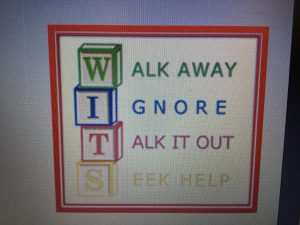Author: Mme Marto (Page 1 of 3)
In an effort to encourage children to solve small conflicts more independently, Aubrey is using a program called WITS to give our students common tools to help them solve problems with their peers.
Below, you will find a picture of what WITS means. Once WITS has been explicitly taught and modelled for the students, our hope is that they will be able to use this program on their own. You may find this useful to try at home.

This week, we are beginning our French speaking incentive program with the grade ones; the grade twos have been doing this for several weeks already . This is how it works:
Each student receives 2 popsicle sticks with their names written on them. If the teacher hears a student speaking primarily in English, the student will lose a stick. Students have the opportunity to win back a lost stick by making a concerted effort to speak in French throughout the rest of the day. Only teachers can take a stick away. If a student has been able to keep their 2 sticks until the end of the day, we will add a check mark next to their name on a class chart. Once they have 5 check marks, they will receive a small candy (individually wrapped and nut-free) as their reward.
In the past, we have tried all kinds of different incentives such as extra centre time, extra outdoor play, bookmarks, pencils, erasers, etc.-those incentives yielded mediocre results. One year, we decided to try using a small candy as a reward. The results were better than anything we could have expected!
The students are excited and nervous about speaking French in class. We understand that we have a class of students at very different stages of their French speaking journey. We take that into account when we ask a student to give us one of their sticks. We have explained to the students that we don’t expect them to know every word in French. What we expect is that they make an effort to use as many French words as they know in their daily conversations with their teachers and classmates. As their vocabulary grows, speaking French in class will become easier. If they lose a stick one day, it’s okay! They get to start again the next day with 2 popsicle sticks.
Just to get the students prepared, we had a few practice sessions last week so that everyone could get a feel for what it’s going to be like.
If you have any questions, please feel free to contact us.